
Good grades are your first priority, and you promised
yourself you wouldn't be distracted. But here you are
writing for the Spectator, playing intramural
basketball and tutoring a fourth-grader once a week.
And the curious thing is, your grades are better than ever.
OUTSIDE THE CLASSROOM BUT INSIDE THE GATESUnlike many other metropolitan colleges and universities, Columbia enjoys the luxury of being a residential campus. Nine out of ten undergraduates-including 99 percent of all first-year sstudents-live on campus in university residence halls. Think of it: thousands of the smartest, most interesting and most self-directed young people from across the country and around the world, all living together in one community. Fifteen residence halls. More than two hundred clubs and organizations. A long campus tradition of students involvement and activism. You just know life will be busy and interesting. Reach out, speak up, join in. Some 125 student organizations operate under the auspices of the student-run Union of Student Organizations (USO). Depending on your interests and inclinations, you'll be able choose among all sorts of arts and cultural organizations, pre-profesional societies, student-focused media and publications staffs, leisure-interest clubs and service organizations. USO also sponsors amore than one hundred other groups that are active throughout campus, including a wide range of athletic, spiritual, community service and Greek letter organizations. Examples of USO groups include Asian American Artists, Barnard/Columbia Students for Choice, the Black Theatre and Performing Arts Ensemble, the Columbia Review, Columbia Television, Filmmakers, Glee Club, Gospel Choir, Jazz Orchestra, King's Court Jugglers, the Industrial Engineers, Marching Band, Model U.N., the Musical Theatre Society, the Philolexian Society, the Society of Women Wngineers and the United Students of Color Council.
|

Need something to do? Here's a sampling of the events and activities you would have learned about by checking out a few campus bulletin boards on one recent afternoon: a Jazz Band concert (with hot cider and crumpets); a performance of Christopher Durang's Marriage of Betty and Boo; a brown-bag event entitled "A Journalist's View of the Middle East"; a course in meditation; a reading by Jamaica Kincaid, Joel Agee and Cynthia Ozick; a speech by the president of the American Indian Law Alliance called "The Invisibility of Native Americans"; the Japan Club's performance of Marat/Sade, something called "Swing Low-a Semiformal Event"; a screening of Reds; a solstice concert at the Cathedral of St. John the Divine; a screening of What's Love Got to Do with it, by the Rape Crisis Anti-Violence Support Center; a concert by pianist Jerome Lowenthal at Miller Theatre; a public lecture on the history of the 1896 Philippine revolution; a coffee-house at Alpha Delta Phi; Sri Chinmoy's annual peace concert; and plea: "Looking for a Christmas ride to Little Rock."
|

It's important to be in an environment that offers you a
wide range of opportunities so that you can select what you
need as you grow and change. You can't be sure what your
interests will be tomorrow.
|
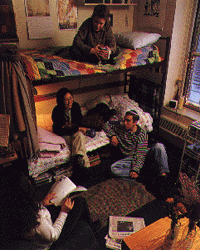
IF YOU HAVE WEB ACCESS You can learn more about campus clubs, activities and organizations online at http: //www.columbia.edu/cu/groups.html. From there, you can point and click your way to information about activities such as Clefhangers (an a capella group), the student councils and the Science Fiction Society; Earl Hall organizations such as the Augustine Club, the Intervarsity Christian Felllowship, Postcrypt Coffeehouse and Women in Science Exchange (WISE); Community Impact; athletic clubs and teams; and numerous Greek-letter organizations. Remember: you'll have your choice of more than two hundred student organizations at Columbia, and the ones we've listed here only begin to suggest how varied they are.
|
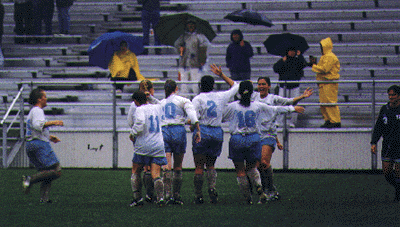
You come to Columbia because you want to be a part of the city. You want to be a grown up, you want to be independent and you want to assert yourself. When I come up out of the subway and see the campus gates, I feel as if I'm home. |
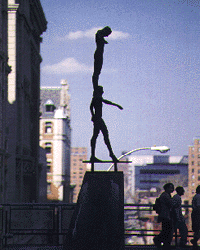 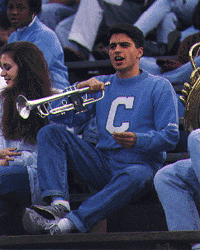
|
What steered me toward Columbia? The variety of social activities here. There's so much to do. Other schools that I looked at had what I wanted academically, but the people there always seemed to be doing the same things. I just wasn't ready to be thrown into any one social pipeline. |
|
Religion and learning, hand in hand. And then there's the Earl Hall Center. Earl Hall, immediatly west of Low Library, is the home of more than sixty other organizations, a dozen of so campus ministries and all sorts of activities that involve spirituality, politics, community service, social discourse, conflict management, the arts, recreation and self-discovery. A student center as well as a religious center, Earl Hall is a safe place for dealing with controversy, a supportive place for seeking answers, a shared place for celebrating and a welcoming place for all. On many campuses, people of different backgrounds or different perspectives can wind up associating almost exclusively with other people like themselves. Part of Earl Hall's mission is to enable Columbia students to break that pattern-even when emotions, political agendas, strongly held beliefs or cultural defferences make it difficult for individuals or groups to see eye-to-eye with each other. In addition to housing and sponsoring sevices and commemorative events (a memorial for the victims of the Tiananmen Square massacre, a display of panels from the AIDS Quilt), Earl Hall administers a year -round program of music instruction, recitals, a variety of other special musical events and the Postcrypt Arts Underground and Postcrypt Coffeehouse, all of which take place in St. Paul's Chapel. And finally, the Earl Hall Center is the principal base of operations for the members of the clergy who maintain the campus ministries that play such an important role in the lives of many members of the Columbia community. Representatives of groups affiliated with the Earl Hall Center together constitute the Student Governing Board, which has significant oversight and advisory responsablities related to membership, budgeting and programming. Among the several dozen groups represented on the Student Governing Board are Amnesty International; the Baptist Campus Ministry; the Coalition for Life; College Democrats; College Republicans; the Disability Interest Group; the Jewish Student Union; the Lesbian, Bisexual and Gay Coalition; the Orthodox Christian Fellowship; the Hindu Sudents' Association; Take Back the Night and the Tibetan Studies Society. Making a difference. Community Impact, which also has offices in Earl Hall, coordinates the work of hundreds of volunteers who operate more than two dozen service projects that benefit some twelve hundred people each week. If you'd like to help out, you'll have all kinds of opportunities to work with advocacy and adult education programs, housing and homelessness programsf, community education programs, companionship programs and programs targeted toward young people. One example: students working with Harlem Restoration Project Project help renovate buildings, apartments and landmarks in Harlem community. Where you'll live. As a first year student you'll live in either Carman Hall, John Jay Hall or Schapiro Hall. Carman is on the west side of Butler Library; John Jay is the one on the east. Schapiro is across the street from Carman. All residence hall rooms are either singles or doubles, and more than 65 percent of all undergraduates live in singles. Kitchens, lounges an laundry facilities are available in most halls. Columbia is well on the way to completing a multy-year program to establish a house system in all undergraduate residence halls. (The project will be finished before the year 2000.) Under the new arrangements, the university is relocating an assistant dean's office to each house, thus affording students in the houses greater access to advising sevices. In addition, a resident professor and a number of faculty affiliates will take part in formal and informal programs with the students who live in each house. During the course of each year, the students, members of the staff and house deans will develop social, cultural and intelectual programs that meet the differing interests and needs of each residential community. As an added benefit, special program coordinators will work closely with first-year students in their houses to help eades the transition to university life. They'll also work with seniors to help resolve issues related to moving on to graduate school or a career. As each house continues to develop its own distinct character and personality, the new system is leading to ever-increasing continuity of undergraduate life inside and outside the classroom. Greek life. Fraternities and sororities offer attractive living options for a number of undergraduate students students. Many of the two dozen or so single-gender and coed Greek-letter organizations at Columbia have their own houses near campus, and all of them choose new members once or or twice each year. Rush is open to all undergraduates at the university. Members who wish to do so may move into their fraternities or sororities after completing their year of study. Between 10 and 15 percent of the undergraduates at the university join Greek houses. The arts on campus. Even though all the cultural resources of New York City are at our doorstep, we take pleasure in presenting, performing, attending and appreciating the arts right on campus. Our standards are high, and the arts at Columbia easily hold their own in the demanding New York City arts environment. For example, Columbia's 684-seat Miller Theater-completely renovated and revitalized less than a decade ago-consistently wins high praise for the grat variety and quality of its offerings. It presents classical and contemporary music in series such as the Distinguished String Quarter, the Composer and the Keyboard, Krosnick and Kalish, Consortium Concerts, Sonic Boom and Jazz in Miller Theatre. The theatre also offers a Literary Series (with readings in the recent past by writers such as Nadine Gordimer, Amos Oz and Susan Sontag) and a film series. Much of Columbia's impressive art collection-paintings, sculptures, prints ans drawings, photographs and decorative arts-is on display throughout the campus. Taking sculpture as an example, look for Daniel Chester French's Alma Mater on the steps of Low Memorial Library; Three-Way Piece:: Points, by Henry Moore, near the Law School; Bellerophon Taming Pegasus, by Jacques Lipschitz, above the entrance to the Law School; a cast of Augustine Rodin's Thinker on the lawn of Philosophy Hall; The Great God Pan, by George Grey Barnard, on the lawn of Lewisohn Hall; Thomas Jefferson, in front of the Journalism Buiding and Alexander Hamilton, in front of Hamilton Hall, both by William Ordway Patridge; and Clement Meadmore's Curl, in front of Uris Hall.
|
|
Since 1986 the Miriam and Ira D. Wallach Art Gallery has provided museum-quality display space for exhibitions organized on campus. During the 1995-96 academic year, exhibits in the gallery included The Post-Pre-Raphaelite Print: Etching, Illustration, Reproductive Engraving and Photography in England in and around the 1860s; Building the Collective: Soviet Graphic Design, 1917-1937; and The Old World Builds the New: The Gustavino Company and the Technology of the Catalan Vault, 1885-1962. Athletics. As a member of the Ivy League, Columbia competes in the NCAA's Division I in all sports. We sponsor men's varsity teams in baseball, basketball, heavyweight crew, lightweight crew, cross country, fencing, football, golf, soccer, swimming and diving, tennis, wrestling and indoor and outdoor track and field. Women's varsity teams compete in archery, basketball, crew, cross country,, fencing, field hockey, lacrosse, soccer, swimming and diving, tennis, volleyball and indoor and outdoor track and field. Some five hundred students take part in more than twenty club sports at Columbia, and thousands enjoy intramural competition in sports such as basketball, flag football, racquetball, indoor and outdoor soccer, softball, squash, swimming, tennis and volleyball. Campus Security. In 1993 USA Today credited Columbia with having the safest campus in the Ivy League. Initiatives such as an escort service and bluelight call boxes enable us to curb crime by preventing it - without limiting students' personal freedom. During orientation for first - year students we offer sessions on security, and students in the residence halls attend floor meetings throughout the year to discuss issuers related to personal safety. Uniformed Columbia University securrity officers are present on the campus and in surrounding areas around the clock. Security personnel also watch over the West Gate and the East Gate (the campus entrances where West 116st meets Broadway and Amsterdam Avenue, respectively) and monitor access to all of the residence halls, the libraries and the Dodge Physical Physical Fitness Center.
|
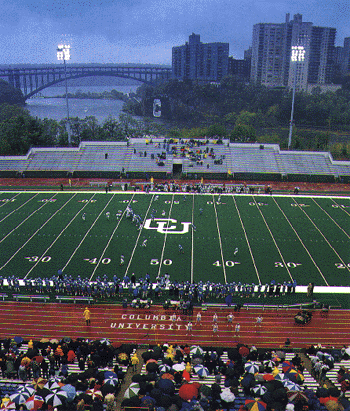
|
Are great athletic facilities on your must-have list? Columbia's Dodge Physical Fitness Center, the campus center for most indoor sports and the most recently renovated physical education facility in the Ivy League, features two full-siza gymnasiums; an eight lane, twenty-five-yard swimming pool; sixteen squash/handball/racquetball courts; an indoor jogging track; fully equipped exercise and weight rooms; a judo-karate room; fencing room; a wrestling rom; an indoor track; and two saunas. A bit farther afield-just uptown of the campus-our twenty-six-acre Baker Field Athletic complex, at 218th Street and Broadway, features a stadium that seats seventeen thousand fans; and eight-lane all-weather track with high jump, pole vault and long jump facilities; a soccer stadium that seats five hundred; a baseball field that seats five hundred; four indoor and three outdoor tennis;crew and rowing facilities; and football and soccer practice fields.
|